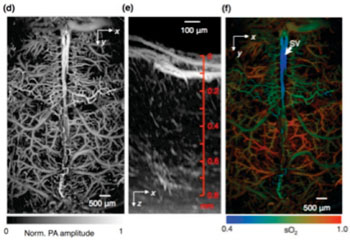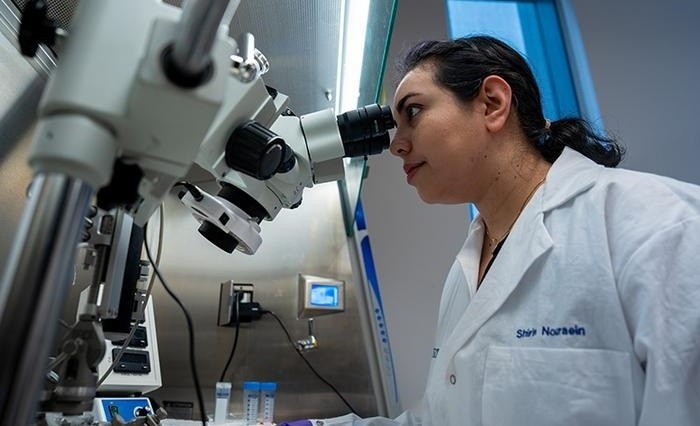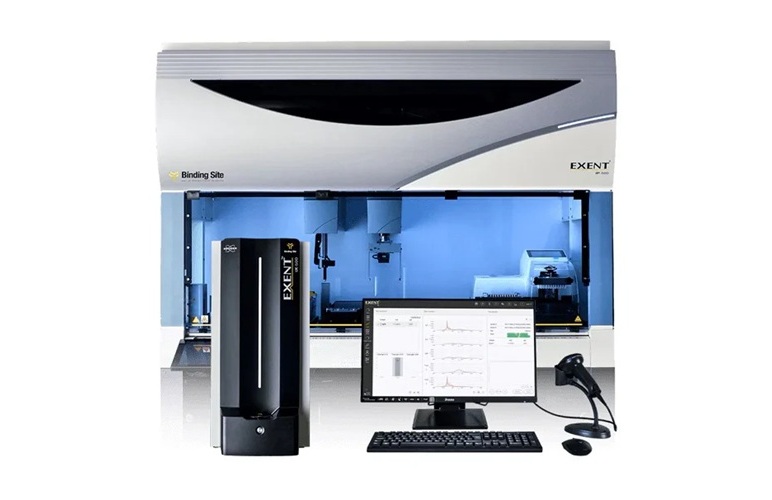Photoacoustic Microscopy Enables Rapid Imaging of the Brain's Oxygen Metabolism
|
By LabMedica International staff writers Posted on 12 Apr 2015 |

Image: Fast functional photoacoustic microscopy of the mouse brain. Figure (d) shows a representative x-y projected brain vasculature image through an intact skull. Figure (e) shows a representative enhanced x-z projected brain vasculature image. Figure (f) shows photoacoustic microscopy of oxygen saturation of hemoglobin in the mouse brain, acquired by using the single-wavelength pulse-width-based method with two lasers (Photo courtesy of Washington University).
Photoacoustic microscopy (PAM) is a novel imaging technique that was exploited by researchers to view the vascular morphology, blood oxygenation, blood flow, and oxygen metabolism in both resting and stimulated states in the mouse brain.
In PAM, non-ionizing laser pulses are delivered into biological tissues. Some of the delivered energy is absorbed and converted into heat, leading to transient thermoelastic expansion and wideband ultrasonic emission. The generated ultrasonic waves are detected by ultrasonic transducers and then analyzed to produce images. Optical absorption is closely associated with physiological properties, such as hemoglobin concentration and oxygen saturation. As a result, the magnitude of the ultrasonic emission (photoacoustic signal), which is proportional to the local energy deposition, reveals physiologically specific optical absorption contrast. Two-dimensional or three-dimensional images of the targeted areas can then be formed.
Investigators at Washington University (St. Louis, MO, USA) recently described using a single-wavelength pulse-width-based PAM method with a one-dimensional imaging rate of 100 kHz to image blood oxygenation with capillary-level resolution in the mouse brain.
They reported in the March 30, 2015, online edition of the journal Nature Methods that this technology enabled them to take images of blood oxygenation 50 times faster than in previous studies using fast-scanning PAM; 100 times faster than an acoustic-resolution system; and more than 500 times faster than phosphorescence-lifetime-based two-photon microscopy (TPM).
“Using this new single-wavelength, pulse-width-based method, PAM is capable of high-speed imaging of the oxygen saturation of hemoglobin,” said senior author Dr. Lihong Wang, professor of biomedical engineering at Washington University. “In addition, we were able to map the mouse brain oxygenation vessel by vessel using this method. PAM is exquisitely sensitive to hemoglobin in the blood and to its color change due to oxygen binding. Without injecting any exogenous contrast agent, PAM allows us to quantify vessel by vessel all of the vital parameters about hemoglobin and to even compute the metabolic rate of oxygen. Given the importance of oxygen metabolism in basic biology and diseases such as diabetes and cancer, PAM is expected to find broad applications.”
Related Links:
Washington University
In PAM, non-ionizing laser pulses are delivered into biological tissues. Some of the delivered energy is absorbed and converted into heat, leading to transient thermoelastic expansion and wideband ultrasonic emission. The generated ultrasonic waves are detected by ultrasonic transducers and then analyzed to produce images. Optical absorption is closely associated with physiological properties, such as hemoglobin concentration and oxygen saturation. As a result, the magnitude of the ultrasonic emission (photoacoustic signal), which is proportional to the local energy deposition, reveals physiologically specific optical absorption contrast. Two-dimensional or three-dimensional images of the targeted areas can then be formed.
Investigators at Washington University (St. Louis, MO, USA) recently described using a single-wavelength pulse-width-based PAM method with a one-dimensional imaging rate of 100 kHz to image blood oxygenation with capillary-level resolution in the mouse brain.
They reported in the March 30, 2015, online edition of the journal Nature Methods that this technology enabled them to take images of blood oxygenation 50 times faster than in previous studies using fast-scanning PAM; 100 times faster than an acoustic-resolution system; and more than 500 times faster than phosphorescence-lifetime-based two-photon microscopy (TPM).
“Using this new single-wavelength, pulse-width-based method, PAM is capable of high-speed imaging of the oxygen saturation of hemoglobin,” said senior author Dr. Lihong Wang, professor of biomedical engineering at Washington University. “In addition, we were able to map the mouse brain oxygenation vessel by vessel using this method. PAM is exquisitely sensitive to hemoglobin in the blood and to its color change due to oxygen binding. Without injecting any exogenous contrast agent, PAM allows us to quantify vessel by vessel all of the vital parameters about hemoglobin and to even compute the metabolic rate of oxygen. Given the importance of oxygen metabolism in basic biology and diseases such as diabetes and cancer, PAM is expected to find broad applications.”
Related Links:
Washington University
Latest BioResearch News
- Genome Analysis Predicts Likelihood of Neurodisability in Oxygen-Deprived Newborns
- Gene Panel Predicts Disease Progession for Patients with B-cell Lymphoma
- New Method Simplifies Preparation of Tumor Genomic DNA Libraries
- New Tool Developed for Diagnosis of Chronic HBV Infection
- Panel of Genetic Loci Accurately Predicts Risk of Developing Gout
- Disrupted TGFB Signaling Linked to Increased Cancer-Related Bacteria
- Gene Fusion Protein Proposed as Prostate Cancer Biomarker
- NIV Test to Diagnose and Monitor Vascular Complications in Diabetes
- Semen Exosome MicroRNA Proves Biomarker for Prostate Cancer
- Genetic Loci Link Plasma Lipid Levels to CVD Risk
- Newly Identified Gene Network Aids in Early Diagnosis of Autism Spectrum Disorder
- Link Confirmed between Living in Poverty and Developing Diseases
- Genomic Study Identifies Kidney Disease Loci in Type I Diabetes Patients
- Liquid Biopsy More Effective for Analyzing Tumor Drug Resistance Mutations
- New Liquid Biopsy Assay Reveals Host-Pathogen Interactions
- Method Developed for Enriching Trophoblast Population in Samples
Channels
Clinical Chemistry
view channel
Chemical Imaging Probe Could Track and Treat Prostate Cancer
Prostate cancer remains a leading cause of illness and death among men, with many patients eventually developing resistance to standard hormone-blocking therapies. These drugs often lose effectiveness... Read more
Mismatch Between Two Common Kidney Function Tests Indicates Serious Health Problems
Creatinine has long been the standard for measuring kidney filtration, while cystatin C — a protein produced by all human cells — has been recommended as a complementary marker because it is influenced... Read moreMolecular Diagnostics
view channel
New Serum Marker-Editing Strategy to Improve Diagnosis of Neurological Diseases
Tracking gene-expression changes in the brain is crucial for understanding neurological diseases, yet current monitoring tools are invasive or unable to capture subtle activity shifts over time.... Read more
World’s First Genetic Type 1 Diabetes Risk Test Enables Early Detection
Type 1 Diabetes (T1D) affects more than eight million people worldwide, with numbers expected to rise sharply. While most cases are genetically driven, only one in ten patients has a family history, making... Read moreHematology
view channel
Platelet Activity Blood Test in Middle Age Could Identify Early Alzheimer’s Risk
Early detection of Alzheimer’s disease remains one of the biggest unmet needs in neurology, particularly because the biological changes underlying the disorder begin decades before memory symptoms appear.... Read more
Microvesicles Measurement Could Detect Vascular Injury in Sickle Cell Disease Patients
Assessing disease severity in sickle cell disease (SCD) remains challenging, especially when trying to predict hemolysis, vascular injury, and risk of complications such as vaso-occlusive crises.... Read more
ADLM’s New Coagulation Testing Guidance to Improve Care for Patients on Blood Thinners
Direct oral anticoagulants (DOACs) are one of the most common types of blood thinners. Patients take them to prevent a host of complications that could arise from blood clotting, including stroke, deep... Read moreImmunology
view channel
Gene Signature Test Predicts Response to Key Breast Cancer Treatment
DK4/6 inhibitors paired with hormone therapy have become a cornerstone treatment for advanced HR+/HER2– breast cancer, slowing tumor growth by blocking key proteins that drive cell division.... Read more
Chip Captures Cancer Cells from Blood to Help Select Right Breast Cancer Treatment
Ductal carcinoma in situ (DCIS) accounts for about a quarter of all breast cancer cases and generally carries a good prognosis. This non-invasive form of the disease may or may not become life-threatening.... Read moreMicrobiology
view channelRapid POC Tuberculosis Test Provides Results Within 15 Minutes
Tuberculosis remains one of the world’s deadliest infectious diseases, and reducing new cases depends on identifying individuals with latent infection before it progresses. Current diagnostic tools often... Read more
Rapid Assay Identifies Bloodstream Infection Pathogens Directly from Patient Samples
Bloodstream infections in sepsis progress quickly and demand rapid, precise diagnosis. Current blood-culture methods often take one to five days to identify the pathogen, leaving clinicians to treat blindly... Read morePathology
view channelAI Tool Outperforms Doctors in Spotting Blood Cell Abnormalities
Diagnosing blood disorders depends on recognizing subtle abnormalities in cell size, shape, and structure, yet this process is slow, subjective, and requires years of expert training. Even specialists... Read more
AI Tool Rapidly Analyzes Complex Cancer Images for Personalized Treatment
Complex digital biopsy images that typically take an expert pathologist up to 20 minutes to assess can now be analyzed in about one minute using a new artificial intelligence (AI) tool. The technology... Read moreTechnology
view channel
AI Saliva Sensor Enables Early Detection of Head and Neck Cancer
Early detection of head and neck cancer remains difficult because the disease produces few or no symptoms in its earliest stages, and lesions often lie deep within the head or neck, where biopsy or endoscopy... Read more
AI-Powered Biosensor Technology to Enable Breath Test for Lung Cancer Detection
Detecting lung cancer early remains one of the biggest challenges in oncology, largely because current tools are invasive, expensive, or unable to identify the disease in its earliest phases.... Read moreIndustry
view channel
Abbott Acquires Cancer-Screening Company Exact Sciences
Abbott (Abbott Park, IL, USA) has entered into a definitive agreement to acquire Exact Sciences (Madison, WI, USA), enabling it to enter and lead in fast-growing cancer diagnostics segments.... Read more


























